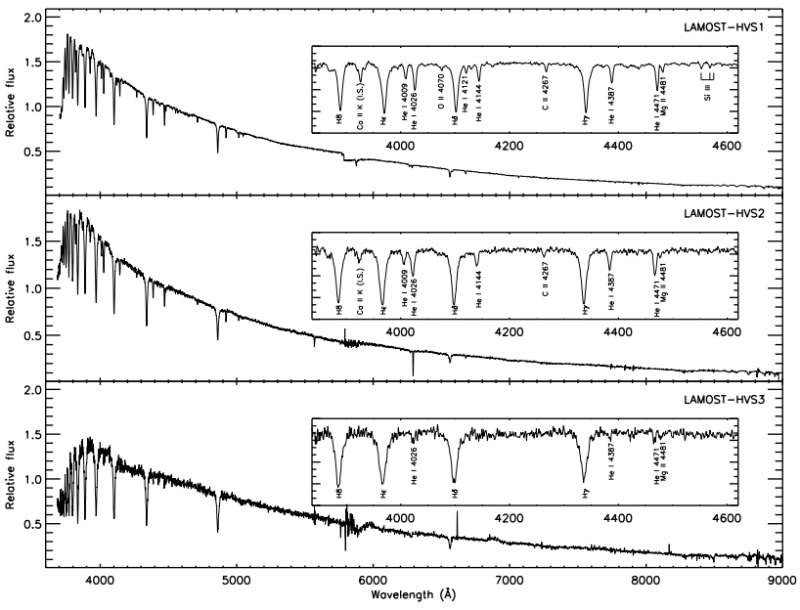September 4, 2017 report
Two distant hypervelocity stars discovered by Chinese astronomers

(Phys.org)—A group of Chinese astronomers led by Yang Huang of the Yunnan University in Kunming, China, has detected two new unbound hypervelocity stars located over 70,000 light years away. The discovery, described in a paper published Aug. 29 on the arXiv pre-print server, could help scientists better understand the nature of these rare, peculiar stars.
Hypervelocity stars (HVSs) are rare objects with velocities so great that they exceed the escape velocity of the galaxy. Astronomers believe that they originate near the center of the Milky Way galaxy by dynamical interactions between binary stars and the central massive black hole. While ordinary stars have velocities around 100 km/s, the velocities of HVSs can reach even 1,000 km/s.
Although scientists estimate that approximately 1,000 HVSs exist in the Milky Way, only about 20 such stars have been identified so far. Given that these objects travel large distances across our galaxy, they could serve as powerful tracers to probe the mass distribution in the Milky Way, providing crucial information about the shape of the galactic dark matter halo. Therefore, finding new HVSs could help us build a valuable database of such tracers.
With this aim in mind, Huang's team have analyzed the available data provided by the LAMOST spectroscopic surveys. The surveys, utilizing the Large Sky Area Multi-Object Fibre Spectroscopic Telescope (LAMOST) in China, investigate the structure and evolution of our galaxy, and have already located one hypervelocity star.
Now, the Chinese astronomers report the finding of two new HVSs in the latest data release from the LAMOST surveys. The researchers found two new unbound hypervelocity stars, designated LAMOST-HVS2 and LAMOST-HVS3. They also re-discovered LAMOST-HSV1 – the first HVS spotted by LAMOST in 2014.
According to the study, LAMOST-HVS2 has a spectral type B2V, mass of about 7.3 solar masses and an effective temperature of 20,600 K. The star, located about 72,500 light years away from the Earth, has a heliocentric radial velocity of 341.1 km/s, which corresponds to a galactic rest-frame radial velocity of 502.33 km/s.
With an effective temperature of 14,000 K, LAMOST-HVS3 is nearly four times as massive as the sun and has a spectral type B7V. The star's heliocentric radial velocity was found to be 361.38 km/s, while its galactic rest-frame radial velocity equals 408.33 km/s. LAMOST-HVS3 is located some 72,760 light years away from our planet.
The researchers assume that the two newly discovered HSVs and the one found earlier may originate from the galactic center and their progenitors are spatially associated with young stellar structures near the center of the Milky Way. However, more studies are needed to confirm this hypothesis. Therefore, the team hopes that the upcoming new data release from ESA's Gaia satellite could shed some light on this problem.
"Finally, accurate proper motion measurements are required in order to better constrain the origin of the three HVSs discovered with LAMOST. The current measurements have uncertainties (systematic plus random) too large to make a conclusive analysis. Fortunately, all the three stars are quite bright and the upcoming Gaia data release should solve this problem," the authors concluded.
More information: Discovery of two new hypervelocity stars from the LAMOST spectroscopic surveys, arXiv:1708.08602 [astro-ph.GA] arxiv.org/abs/1708.08602
Abstract
We report the discovery of two new unbound hypervelocity stars (HVSs) from the LAMOST spectroscopic surveys. They are respectively a B2V type star of ~ 7 M⊙ with a Galactic rest-frame radial velocity of 502 km/s at a Galactocentric radius of ~ 21 kpc and a B7V type star of ~ 4 M⊙ with a Galactic rest-frame radial velocity of 408 km/s at a Galactocentric radius of ~ 30 kpc. The origins of the two HVSs are not clear given their currently poorly measured proper motions. However, the future data releases of Gaia should provide proper motion measurements accurate enough to solve this problem. The ongoing LAMOST spectroscopic surveys are expected to yield more HVSs to form a statistical sample, providing vital constraint on understanding the nature of HVSs and their ejection mechanisms.
© 2017 Phys.org



















